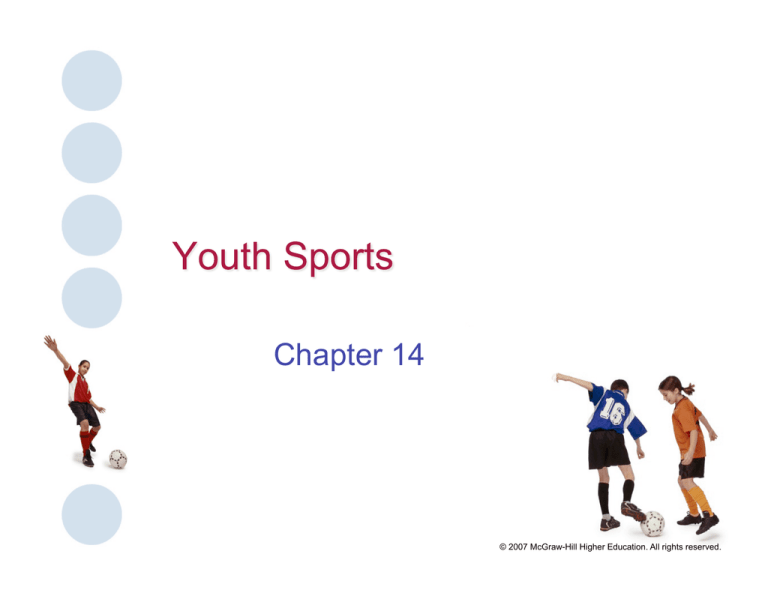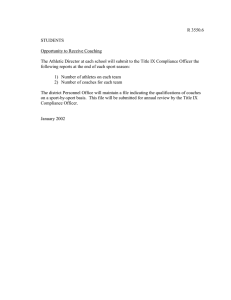
Chapter 14
© 2007 McGraw-Hill Higher Education. All rights reserved.
• Athletic endeavors that provide children
and youth with a systematic sequence
of practices and contests
• 39 million youth participate in nonschool
sponsored programs
• 7 million youth participate in
interscholastic sports
© 2007 McGraw-Hill Higher Education. All rights reserved.
• Why are so many children involved?
– Trend toward earlier participation
• A 4-year-old holds the age group record for
running a marathon
– Increase in female participation
• The number of interscholastic sports for
girls has increased from 14 (1971) to 41
(1999)
© 2007 McGraw-Hill Higher Education. All rights reserved.
• Why are so many children
involved?
– Children are beginning to get involved
in what used to be considered
nontraditional sport activities
• Tennis, cycling, bowling, ice hockey, crosscountry skiing
– Rule changes
• Even the youngest child can experience
success
© 2007 McGraw-Hill Higher Education. All rights reserved.
• Why are so many children
involved?
– There is an increased in the number of
disabled children who participate
• American Wheelchair Bowling Association
• Handicapped Scuba Association
• National Foundation of Wheelchair Tennis
• National Wheelchair Softball Association
• Special Olympics
• United States Quad Rugby Association
© 2007 McGraw-Hill Higher Education. All rights reserved.
• Benefits of youth sport activities
– Academic performance improvement
– Physical fitness
– Self-esteem enhancement
– Deterrent to negative behavior
© 2007 McGraw-Hill Higher Education. All rights reserved.
Girls
Boys
Basketball
Football
Outdoor track & field
Basketball
Volleyball
Outdoor track & field
Fast pitch softball
Baseball
Soccer
Soccer
Cross-country
Wrestling
Tennis
Cross-country
Swimming & diving
Golf
Competitive spirit squads
Tennis
Golf
Swimming & diving
© 2007 McGraw-Hill Higher Education. All rights reserved.
•
•
•
•
•
•
•
To have fun
To improve skills
To be with friends
To be part of a team
To experience excitement
To receive awards
To win
• To become physically fit
(Wankel & Kreisel, 1985)
© 2007 McGraw-Hill Higher Education. All rights reserved.
• If asked a child what a fun practice was
what would their response be?
© 2007 McGraw-Hill Higher Education. All rights reserved.
• Wankel and Kreisel (1985)
– Emphasis should be on involvement,
skill development, and enjoyment of
doing the skills
– According to the children, winning and
receiving rewards for playing are of
secondary importance
© 2007 McGraw-Hill Higher Education. All rights reserved.
• Harter’s Model
– Individuals are motivated to be successful in
various achievement areas such as sports,
academics, or human relationships
– When performance is successful, there is a
positive effect on the individual
– Individuals have a high need to demonstrate what
they have learned
– When performance is not successful, the
individual will most likely quit
© 2007 McGraw-Hill Higher Education. All rights reserved.
• Younger children evaluate their physical
competence based upon game outcome and
parental feedback
– Below ages of 10-11, children usually evaluate
there self-worth based on what people of high
status state about their performances
• Older children and adolescents use social
comparisons and evaluation by peers
• Children become more accurate in personal
assessment of physical competence as they
age
© 2007 McGraw-Hill Higher Education. All rights reserved.
• Contrary to popular belief, children do not
drop out of sports because of stress
• More often, withdrawing from a sport is due
to:
– Interpersonal problems
– Unable to demonstrate what they can do!
• Pursue other leisure activities
• Researchers report that a majority of
“dropouts” reenter the same or new sport
– Caution should be used when using the term
“sport dropout”
© 2007 McGraw-Hill Higher Education. All rights reserved.
11 Most Important Reasons Children Stop Playing a Sport
(Athletic Footwear Association, 1990)
1.
2.
3.
4.
5.
6.
I wasn’t able to
demonstrate what I could
do (lost interest)
I was not having fun
It took too much time
Coach was a poor
teacher
There was too much
pressure
I wanted a nonsport
activity
7.
8.
9.
10.
11.
I was tired of it
I needed more study time
Coach played favorites
The sport was boring
There was an
overemphasis on winning
© 2007 McGraw-Hill Higher Education. All rights reserved.
Six Most Important Changes Children Would Make in a Sport
That Was Previously Dropped
(Athletic Footwear Association, 1990)
BOYS
1.
2.
3.
4.
5.
6.
“I would play again if”
Practices were challenging
I could play more (demonstrate
what they can do!)
Coaches understood players
better
There was no conflict with
studies
Coaches were better teachers
There was no conflict with social
life
1.
2.
3.
4.
5.
6.
GIRLS
Practices were challenging
There was no conflict with
studies
Coaches understood players
better
There was no conflict with social
life
I could play more (demonstrate
what they can do!)
Coaches were better teachers
© 2007 McGraw-Hill Higher Education. All rights reserved.
1. Coach develops an expectation for each child that
predicts the level of performance and type of
behavior that child will exhibit over the course of the
season.
2. The coach’s expectations influences his or her
treatment of the child.
3. The what in which the coach treats each athlete
affects the child’s performance and rate of learning.
How the coach treats child affects the child’s selfworth.
4. The child’s behavior and performance conforms to
the coach’s expectations.
© 2007 McGraw-Hill Higher Education. All rights reserved.
• Coaches form the child’s expectations
on person cues
• Coaches form the child’s expectations
on performance information
• Coaches form the child’s expectations
on psychological characteristics
© 2007 McGraw-Hill Higher Education. All rights reserved.
• Do coaches treat children with high
ability differently than children who have
lower abilities?
– High expectant children
– Low expectant children
© 2007 McGraw-Hill Higher Education. All rights reserved.
• Low expectant children who are
consistently given less effective and
less intensive instruction or who are
allowed less active time to practice will
not show the same degree of skill
improvement as the high expectant
child.
• Coach’s biased instructional behavior
has an effect on the child’s rate of
learning, and psychological growth.
© 2007 McGraw-Hill Higher Education. All rights reserved.
• Due to the low expectant child
instruction and practice is different in
quantity and quality when this child is
given the opportunity to play, they
usually confirm the coaches
expectations.
© 2007 McGraw-Hill Higher Education. All rights reserved.
1.
2.
3.
4.
5.
6.
7.
8.
Coaches need to rely on performance based information
across the season.
Coaches need to realize that their initial assessment of the
child may be inaccurate need to be revised continually across
the season.
During practice, coaches need to keep a running count of time
each athlete spends in non-skill related activities
Coaches need to design instructional activities for provide all
children an opportunity.
Coaches should respond to skill errors with corrective
instruction.
Coaches need to emphasize skill improvement.
Coaches need to interact frequently with all the children on the
their team.
Coaches should try to create a mastery-oriented climate.
© 2007 McGraw-Hill Higher Education. All rights reserved.
There seems to be a rise in the number of
learned helpless children.
Children have a high fear of failing and
causally contribute their success and
failing to unstable, external factors.
These children need to under go reattributional retraining.
© 2007 McGraw-Hill Higher Education. All rights reserved.
1) Incident & frequency of injury
2) Type of injury
3) Reduction of injuries
© 2007 McGraw-Hill Higher Education. All rights reserved.
Across all youth sports the incident &
frequency of injury is very low (e.g.,
football is about 5%).
© 2007 McGraw-Hill Higher Education. All rights reserved.
• Acute
– Collision injuries (football & soccer)
– Chest & eye injury (Baseball)
– Falls (inline skating & down hill skiing)
• Overuse
– Osgood-Schlatter Disease
– Sever’s disease
– Little league elbow
– Patellar Femoral
© 2007 McGraw-Hill Higher Education. All rights reserved.
• Better officiating
• Equipment
– Softer balls in baseball & softball
– Protective gear
• Rule changes (e.g. little league baseball
pitch count)
• Avoid overtraining
© 2007 McGraw-Hill Higher Education. All rights reserved.
• Psychological issues
– Stress
• Unpleasant emotional state
– Reducing competitive stress
• Are young athletes being exposed to
too much competitive stress?
© 2007 McGraw-Hill Higher Education. All rights reserved.
Model depicting the development of stress and potential behavioral outcomes
Situation
Individual views outcome
as important &
evaluative
Appraisal
Individual evaluates his/her
ability to the demands
of the situation
Consequences
Withdraw and try a new
sport; Withdraw
permanently
Emotional Response
Unfavorable appraisal
leads to physiological
and cognitive stress
Passer, 1982
© 2007 McGraw-Hill Higher Education. All rights reserved.
• Youth sport participation is not the only
stress encountered in the daily life of a
young person
• Precompetitive state anxiety
– Study by Simon & Marten (1979)
– 468 children in youth sports
– 281 children who competed in a physical
education softball game, school test, group
competition in band, and band solo
competition
© 2007 McGraw-Hill Higher Education. All rights reserved.
Result: note the greatest level of precompetitive
state anxiety is for band solo students
Children’s precompetitive state anxiety in 11 sport activities.
The precompetitive state anxiety scale ranges from 10-30.
• Change something about the sport
so that success occurs more often
than failure
– T-ball uses stationary batting tee
instead of a pitcher
• Skill training instills confidence
– More time should be spent on
teaching and less time on scrimmaging
© 2007 McGraw-Hill Higher Education. All rights reserved.
• Children who perceive themselves
as competent are less threatened
and perform better
• Winning/losing should be placed in
perspective
– Child may feel that he/she has
disappointed parents or coach
• Help child set realistic goals
© 2007 McGraw-Hill Higher Education. All rights reserved.
• Who’s coaching our children?
– 9 out of 10 volunteer coaches are men
• 90% lack the necessary formal preparation to coach
• Why is there a lack of women youth coaches?
• Safe on First
– An organization designed to run background
checks on those who coach children
– Sex offenders, criminal record, etc.
– Safe on First Web Site
© 2007 McGraw-Hill Higher Education. All rights reserved.
• The annual turnover rate for
coaches is 50%
• There is a rise in the number of
lawsuits directed toward youth
sport coaches and organizations
because of alleged negligence
during practices and games
© 2007 McGraw-Hill Higher Education. All rights reserved.
• A coach overly concerned with winning
and losing and/or is ego-involved is
considered to be an task-oriented
coach.
• A coach who emphasis is on
improvement and skill mastery is
considered to be a mastery oriented
coach.
© 2007 McGraw-Hill Higher Education. All rights reserved.
Performance
Oriented
Belief about athletic
ability
Good athlete are born Athletic ability is
that way
something that can
be developed
Belief about coaching My team is not
success
successful because I
did not have good
athletes
Stereotypic beliefs
Mastery Oriented
Good game plan and
practices result in
success
Athlete success is
Coaches behaviors
based on gender,
with the athlete is
race, ethnicity,
individualized
country of origin, and
socioeconomic status
© 2007 McGraw-Hill Higher Education. All rights reserved.
Effect
Performance
Oriented
Mastery Oriented
Enjoyment &
interest
Low
High
Self-esteem
Low
High
Skill mastery
Low
High
Stress
High
Low
© 2007 McGraw-Hill Higher Education. All rights reserved.
• The National Standards for Athletic
Coaches has recently been
established
– These standards are endorsed by over
140 sport organizations
• Technological advances now allow
educators to reach more potential
youth sport coaches to obtain
coaching education and
certification
© 2007 McGraw-Hill Higher Education. All rights reserved.
• National Standards for Athletic Coaches
– Injury care and prevention
– Risk management
– Knowledge of growth and development
– Training, conditioning, and nutrition
– Social/psychological aspects of coaching
– Skills, tactics, strategies
– Teaching and administration
– Professional preparation and development
© 2007 McGraw-Hill Higher Education. All rights reserved.
•
•
•
•
American Sport Education Program
Coaching Association of Canada
National Alliance for Youth sports
National Association for Sports and Physical
Education
• National Federation of State High School
Associations
• Youth Sports Institute-Michigan State
University
• Institute for the Study of Youth Sports
© 2007 McGraw-Hill Higher Education. All rights reserved.
© 2007 McGraw-Hill Higher Education. All rights reserved.






